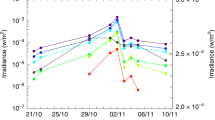Abstract
An Extreme ultraviolet (EUV) Camera was installed onboard the Chinese lunar surface landing mission, the Chang’E-3 lander, as a useful method to observe the Earth plasmasphere. This EUV optical payload obtained more than 600 moon-based Earth plasmasphere images since December 14, 2013. However, due to errors of unknown size and origin in the platform attitude control of the lander and in the EUV telescope pointing control during the mission operating periods, the geocentric coordinates in these EUV images are not fixed in the same position of CCD pixel. Before adequately calibrating, these positioning offsets will introduce extra errors into the analysis of the plasmaspheric structure. With only a little insufficient telemetry information, an effective calibrating method of circle-based differential algorithm is suggested and demonstrated, for automatically and precisely detecting the geocentric position in each EUV image of Chang’E-3 mission. In each EUV image, the tested method uses the outline of a circle as the basic unit to capture the contour for the bright region based on the spectral characteristic. Then, the center of the extracted circle is adopted as the geocentric position for the image. The preliminary analysis shows that this method can effectively detect the geocentric position being always consistent with the recognition result by the basic hand labor method. It is found that the radius of the circles varies from month to month from December, 2013 to May, 2014. The monthly averages of radius show relative notable positive correlation and negative correlation with the changes of both Zenith angle of the Earth at the landing area of Chang’E-3 lander, and the Earth-moon distance, respectively. This method and results here will benefit the Chang’E-3 EUV study.










Similar content being viewed by others
References
Carpenter, D.L.: J. Geophys. Res. 68, 1675 (1963)
Carpenter, D.L.: J. Geophys. Res. 71, 693 (1966)
Chen, B., Song, K.F., Li, Z.H., et al.: Res. Astron. Astrophys. 14, 1654 (2014)
Davis, M.W., Gladstone, G.R., Goldstein, J., et al.: In: Proc. Conference on UV, X-Ray, and Gamma-Ray Space Instrumentation for Astronomy XVIII, San Diego, CA (2013)
Dent, Z.C., Mann, L.R., Menk, F.W., Goldstein, J.: Geophys. Res. Lett. 30, 2 (2003)
Feng, J.Q., Liu, J.J., He, F., et al.: Res. Astron. Astrophys. 14, 1664 (2014)
Fu, H.S., Tu, J., Cao, J.B., et al.: J. Geophys. Res. 115, A07227 (2010)
Gallagher, D.L., Adrian, M.L.: J. Atmos. Sol.-Terr. Phys. 69, 341 (2007)
Gonzalez, R.C., Woods, R.E.: Digital Image processing, 3rd edn. Pearson Prentice Hall, New Jersey (2008)
He, F., Zhang, X.X., Chen, B., Fok, M.C.: Sci. China, Technol. Sci. 53, 200 (2010)
He, F., Zhang, X.X., Chen, B., Fok, M.C., Zou, Y.L.: J. Geophys. Res. 118, 7085 (2013)
Hoogeveen, G.W., Jacobson, A.R.: Ann. Geophys. 15, 236 (1997)
Keyser, J.D., Carpenter, D.L., Darrouzet, F., Gallagher, D.L., Tu, J.N.: Space Sci. Rev. 145, 7 (2009)
Lemaire, J.F., Gringauz, K.I.: The Earth’s Plasmasphere. Cambridge University Press, Cambridge (1998)
Lemaire, J., Storey, L.R.O.: J. Atmos. Sol.-Terr. Phys. 63, 1105 (2001)
Li, L., Chen, Z.Q., Xu, R.L., Kang, K., et al.: Adv. Space Res. 43, 1143 (2009)
Meier, R.R., Nicholas, A.C., Picone, J.M., et al.: J. Geophys. Res. 103, 505 (1998)
Nakamu, M., Yoshika, I., Yamaza, A., et al.: Geophys. Res. Lett. 27, 141 (2000)
Sandel, B.R., King, R.A., Forrester, W.T., et al.: Geophys. Res. Lett. 28, 1439 (2001)
Sandel, B.R., Goldstein, J., Gallagher, D.L., Spasojevic, M.: Space Sci. Rev. 109, 25 (2003)
Singh, A.K., Singh, R.P., Devendraa Siingh: Planet. Space Sci. 59, 810 (2011)
Storey, L.R.O.: Philos. Trans. R. Soc. 246, 113 (1953)
Wu, B., Li, F., Ye, L., et al.: Earth Planet. Sci. Lett. 405, 257 (2014)
Yoshika, I., Yamaza, A., Murakami, G., et al.: Earth Planets Space 60, 407 (2008)
Yoshika, I., Murakami, G., Ogawa, G., et al.: J. Geophys. Res. 115, A04217 (2010)
Acknowledgements
The authors are very grateful to the editor and the anonymous referee for comments and suggestions which led to the present improved version of the paper. All the authors acknowledge support from the Key Research Program of the Chinese Academy of Sciences (grant Y422013V01-CE-3), the national key basic research and development plan (Grant No. 2015CB857101). This work was also supported in part by the National Natural Science Foundation of China (Grant 41301470 and 41101425), the key research of Henan provincial univeristies (Grant 15A420001) and the basic research funds for the Henan provincial universities. We also thank the EUVC instrument team of Chang’E 3 mission for their help.
Author information
Authors and Affiliations
Corresponding author
Rights and permissions
About this article
Cite this article
Zheng, C., Ping, J., Wang, M. et al. Geocentric position preliminary detection from the extreme ultraviolet images of Chang’E-3. Astrophys Space Sci 358, 28 (2015). https://doi.org/10.1007/s10509-015-2427-z
Received:
Accepted:
Published:
DOI: https://doi.org/10.1007/s10509-015-2427-z




